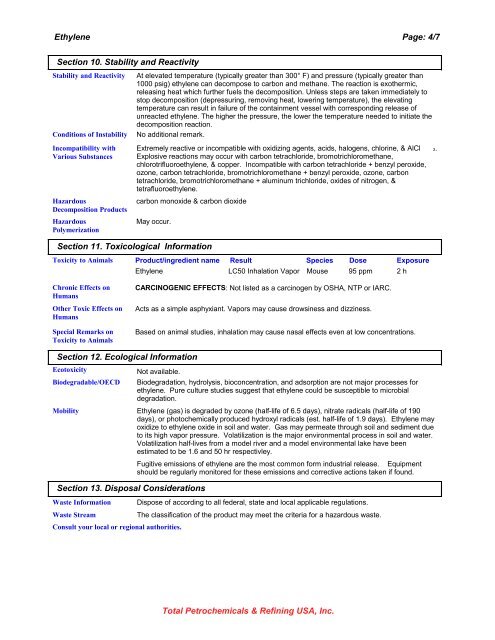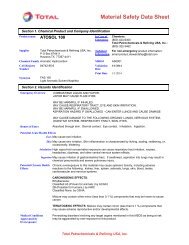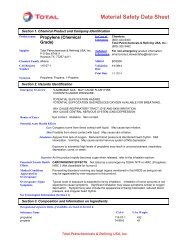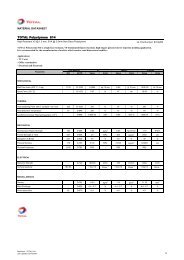6148 Ethylene - Total Refining & Chemicals
6148 Ethylene - Total Refining & Chemicals
6148 Ethylene - Total Refining & Chemicals
You also want an ePaper? Increase the reach of your titles
YUMPU automatically turns print PDFs into web optimized ePapers that Google loves.
<strong>Ethylene</strong> Page: 4/7Section 10. Stability and ReactivityStability and ReactivityConditions of InstabilityIncompatibility withVarious SubstancesHazardousDecomposition ProductsHazardousPolymerization_At elevated temperature (typically greater than 300° F) and pressure (typically greater than1000 psig) ethylene can decompose to carbon and methane. The reaction is exothermic,releasing heat which further fuels the decomposition. Unless steps are taken immediately tostop decomposition (depressuring, removing heat, lowering temperature), the elevatingtemperature can result in failure of the containment vessel with corresponding release ofunreacted ethylene. The higher the pressure, the lower the temperature needed to initiate thedecomposition reaction.No additional remark.Extremely reactive or incompatible with oxidizing agents, acids, halogens, chlorine, & AlCl 3.Explosive reactions may occur with carbon tetrachloride, bromotrichloromethane,chlorotrifluoroethylene, & copper. Incompatible with carbon tetrachloride + benzyl peroxide,ozone, carbon tetrachloride, bromotrichloromethane + benzyl peroxide, ozone, carbontetrachloride, bromotrichloromethane + aluminum trichloride, oxides of nitrogen, &tetrafluoroethylene.carbon monoxide & carbon dioxideMay occur.Section 11. Toxicological InformationToxicity to AnimalsProduct/ingredient name Result Species Dose Exposure<strong>Ethylene</strong> LC50 Inhalation Vapor Mouse 95 ppm 2 hChronic Effects onHumansOther Toxic Effects onHumansSpecial Remarks onToxicity to AnimalsCARCINOGENIC EFFECTS: Not listed as a carcinogen by OSHA, NTP or IARC.Acts as a simple asphyxiant. Vapors may cause drowsiness and dizziness.Based on animal studies, inhalation may cause nasal effects even at low concentrations.Section 12. Ecological InformationEcotoxicityBiodegradable/OECDMobilityNot available.Section 13. Disposal ConsiderationsWaste InformationWaste StreamConsult your local or regional authorities.Biodegradation, hydrolysis, bioconcentration, and adsorption are not major processes forethylene. Pure culture studies suggest that ethylene could be susceptible to microbialdegradation.<strong>Ethylene</strong> (gas) is degraded by ozone (half-life of 6.5 days), nitrate radicals (half-life of 190days), or photochemically produced hydroxyl radicals (est. half-life of 1.9 days). <strong>Ethylene</strong> mayoxidize to ethylene oxide in soil and water. Gas may permeate through soil and sediment dueto its high vapor pressure. Volatilization is the major environmental process in soil and water.Volatilization half-lives from a model river and a model environmental lake have beenestimated to be 1.6 and 50 hr respectivley.Fugitive emissions of ethylene are the most common form industrial release. Equipmentshould be regularly monitored for these emissions and corrective actions taken if found.Dispose of according to all federal, state and local applicable regulations.The classification of the product may meet the criteria for a hazardous waste.<strong>Total</strong> Petrochemicals & <strong>Refining</strong> USA, Inc.
















